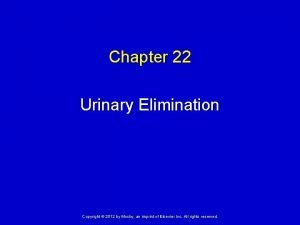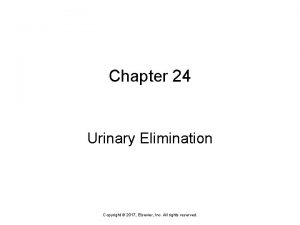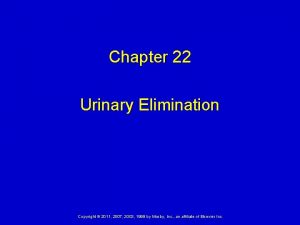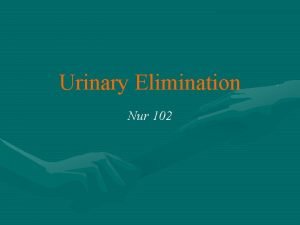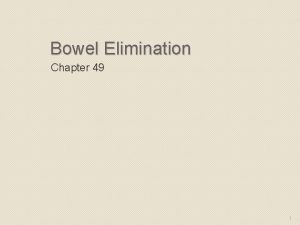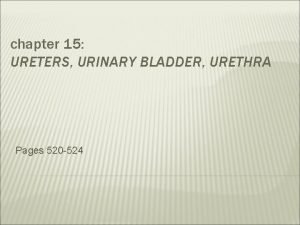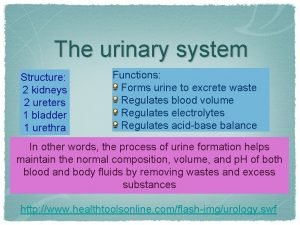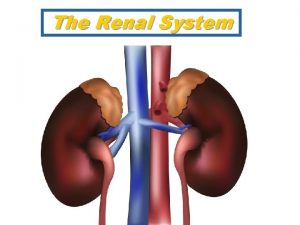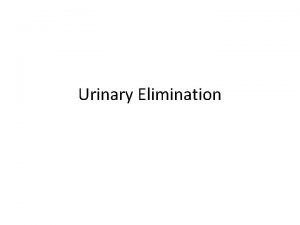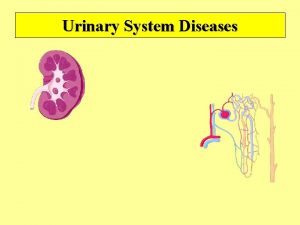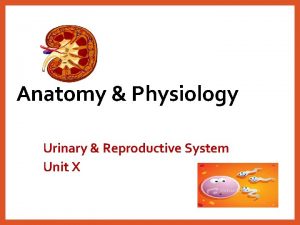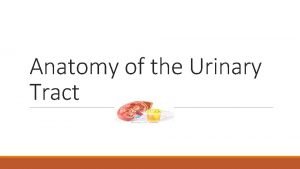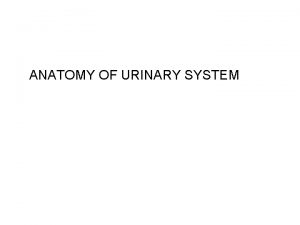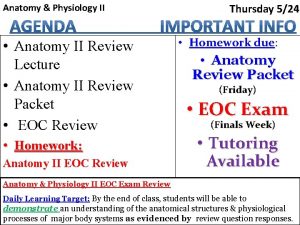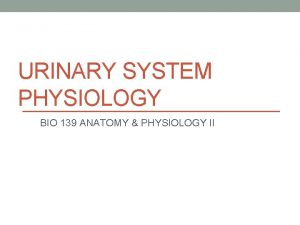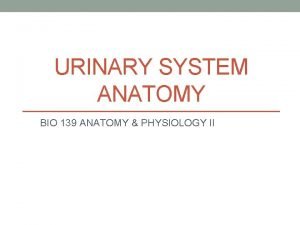Review of Anatomy and Physiology of Urinary Elimination













- Slides: 13

Review of Anatomy and Physiology of Urinary Elimination Chapter 15

Purpose of the need for urinary elimination (More depth than textbook –g 449) n o Maintain homeostasis = maintain the consistency of the internal environment in which cells live & work n o Excrete waste Ultra violet light enters the skin, and is converted to its active form in the kidneys n Active form needed to absorb calcium in the GI tract Regulate volume & composition of the extra cellular fluid o n n Adjust salt/water concentration Control acid/base balance – excrete acids Produces 2 hormones o Erythropoietin (Stimulate RBC production) o Renin (help control BP)

REVIEW OF TERMS FROM SCIENCE o Osmotic pressure – pressure exerted on a differentially permeable membrane separating a solution from a solvent – the membrane being impermeable to the solutes in the solution & only permeable to the solvent n Pressure of a colloid in a solution

Note: Definitions taken from Mosby’s Medical, Nursing, & Allied Health Dictionary o Hydrostatic Pressure n n o Pressure exerted by a liquid Pushing force Colloid osmotic pressure & Oncotic pressure n Pressure of a colloid in a solution o o Higher concentration of protein in the plasma than in the interstitial fluid Pulling force

Hydration terms o Isotonic o Anuria o Hypotonic o Oliguria o Hypertonic o Polyuria

ANATOMY- wikipedia

Functioning Unit – Nephron o 6 sections n Glomerulus (tuff of capillaries) n Bowman’s Capsule n Proximal Convoluted Tubule n Loop of Henle n Distal Convoluted Tubule n Collecting Duct You tube

Nephron = Wikipedia

Flow through the nephron from ADAM

Physiology: Urine Formation http: //users. rcn. com/jkimball. ma. ultranet/Biology. Pages/K/Kidney. html

Amazing Facts o o o Kidneys get 25% of CO (CO = 5 L/Min) 1200 blood passes through the kidneys/min 125 ml blood/min is filtered from all glomeruli At 125 ml/min X 60 min = 7500 ml/ hr 7500 ml X 24 hr = 180 L/day (45 gal) Blood cleansed 60 times a day

Bladder http: //antranik. org/the-urinary-system-ureter-and-urinarybladder/

Diagnostic Tests See Mc. Connell pg 453 - 456 UA Specific gravity = plasma 1. 01 protein & various casts (protein & cellular debris molded in the shape of the tubular lumen) Creatinine clearance Serum Creatinine – may increase 1 -2 mg/dl/day levels of 15 -30 mg/dl are possible with severe renal problems BUN increases 10 - 15 mg/dl/day – levels may reach 200 mg/dl with Electrolytes severe renal problems
 Chapter 22 urinary elimination
Chapter 22 urinary elimination Chapter 24 urinary elimination
Chapter 24 urinary elimination Chapter 22 urinary elimination
Chapter 22 urinary elimination Impaired urinary elimination
Impaired urinary elimination Alterations in urinary elimination
Alterations in urinary elimination Gauss elimination
Gauss elimination Parallax enema
Parallax enema Urethra
Urethra What is the name
What is the name Urinary system anatomy
Urinary system anatomy Upper respiratory diagram
Upper respiratory diagram Tattoo anatomy and physiology
Tattoo anatomy and physiology International anatomy olympiad
International anatomy olympiad Incomplete flower
Incomplete flower
